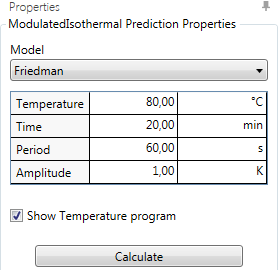Predictions: Modulated Isothermal
Predictions of the signal, conversion, conversion rate, concentration or reaction rate can be made for a modulated temperature (“quasi-isothermal”). A modulated isothermal temperature program is the sum of an underlying constant temperature and sinus-shaped temperature oscillations.

First, a Method/Model (model-free or model-based) needs to be selected (here: Friedman), where only those models are offered with which the data were already analyzed.
- Temperature is the mean isothermal temperature.
- Time defines the entire duration of the simulation calculated.
- Period is the duration of one modulation cycle.
- Amplitude defines the temperature amplitude of the modulation. The temperature will oscillate within ± Amplitude around the underlying constant temperature.
Default values are suggested by the software according to the experimental data.
Show Temperature program can only be activated if the X-axis unit is set to time.
Press Calculate for calculations/update of calculations.
Exemplary results:

In this example, the simulated signal curve is shown together with the defined modulated temperature as a function of time.
Customization and exporting of the results can be done via Ribbon Toolbar.